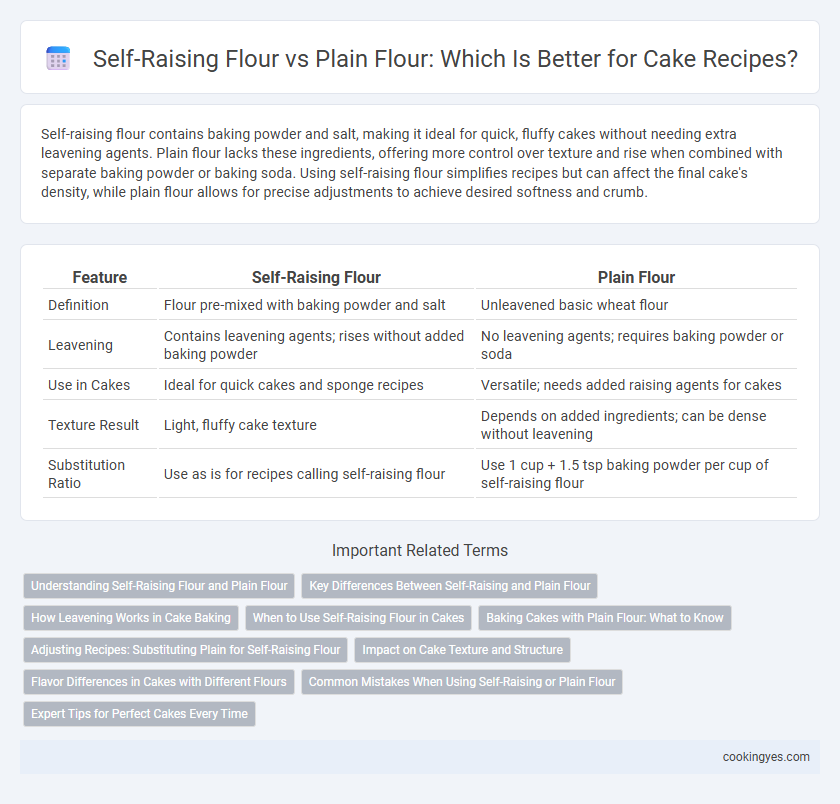Self-raising flour contains baking powder and salt, making it ideal for quick, fluffy cakes without needing extra leavening agents. Plain flour lacks these ingredients, offering more control over texture and rise when combined with separate baking powder or baking soda. Using self-raising flour simplifies recipes but can affect the final cake's density, while plain flour allows for precise adjustments to achieve desired softness and crumb.
Table of Comparison
| Feature | Self-Raising Flour | Plain Flour |
|---|---|---|
| Definition | Flour pre-mixed with baking powder and salt | Unleavened basic wheat flour |
| Leavening | Contains leavening agents; rises without added baking powder | No leavening agents; requires baking powder or soda |
| Use in Cakes | Ideal for quick cakes and sponge recipes | Versatile; needs added raising agents for cakes |
| Texture Result | Light, fluffy cake texture | Depends on added ingredients; can be dense without leavening |
| Substitution Ratio | Use as is for recipes calling self-raising flour | Use 1 cup + 1.5 tsp baking powder per cup of self-raising flour |
Understanding Self-Raising Flour and Plain Flour
Self-raising flour is a blend of plain flour, baking powder, and sometimes salt, designed to provide leavening directly in cake recipes, resulting in lighter and fluffier textures. Plain flour, also known as all-purpose flour, lacks any added raising agents and requires the baker to add baking powder or baking soda separately to achieve the desired rise. Selecting between self-raising and plain flour impacts the cake's density, crumb structure, and overall rise, making it essential to understand their differences for accurate recipe execution.
Key Differences Between Self-Raising and Plain Flour
Self-raising flour contains added baking powder and salt, which helps cakes rise without the need for additional leavening agents, making it ideal for quick and straightforward cake recipes. Plain flour, also known as all-purpose flour, lacks these additives, requiring the baker to manually incorporate baking powder or baking soda to achieve the desired rise and texture. Choosing between self-raising and plain flour significantly impacts the cake's crumb structure, moisture, and overall fluffiness.
How Leavening Works in Cake Baking
Self-raising flour contains a pre-mixed blend of leavening agents such as baking powder, which releases carbon dioxide gas when moistened and heated, causing the cake batter to rise and develop a light, airy texture. Plain flour lacks these leavening agents, requiring the baker to add baking powder or baking soda separately to achieve the desired rise and crumb structure. Understanding the chemical reaction between leavening agents and moisture in cake baking is crucial for controlling texture and volume in the final product.
When to Use Self-Raising Flour in Cakes
Self-raising flour is ideal for cakes that need a light and airy texture, as it contains a leavening agent that helps the batter rise without additional baking powder. Use self-raising flour in recipes specifically designed for it, such as sponge cakes or simple fruit cakes, to achieve a consistent rise and crumb structure. Avoid substituting it in recipes calling for plain flour unless you adjust the leavening agents accordingly to prevent over-rising or dense texture.
Baking Cakes with Plain Flour: What to Know
Baking cakes with plain flour requires adding a leavening agent such as baking powder or baking soda to ensure proper rise and light texture. Plain flour has a lower protein content compared to self-raising flour, making it versatile for various cake recipes but demanding accurate measurements of raising agents. Understanding the balance between flour type and leavening helps achieve moist, tender cakes with desirable crumb structure.
Adjusting Recipes: Substituting Plain for Self-Raising Flour
When substituting plain flour for self-raising flour in cake recipes, add 1 1/2 teaspoons of baking powder per cup of plain flour to achieve the proper rise. Omitting this adjustment can result in dense, flat cakes due to insufficient leavening agents. Accurate measurement and thorough mixing of baking powder with plain flour ensure optimal texture and crumb in the final baked product.
Impact on Cake Texture and Structure
Self-raising flour contains baking powder, which releases gas during baking to create a lighter and airier cake texture, making it ideal for recipes requiring a soft crumb and delicate rise. Plain flour lacks these leavening agents, producing a denser and firmer structure that suits richer, heavier cakes or layered desserts needing stability. Selecting the correct flour directly impacts the cake's volume, crumb softness, and overall mouthfeel, crucial for achieving the desired final texture.
Flavor Differences in Cakes with Different Flours
Self-raising flour contains baking powder and salt, which can produce a lighter, airier cake with a subtly different flavor profile compared to plain flour. Cakes made with plain flour rely on separately added leavening agents, allowing greater control over taste and texture, often resulting in a more neutral flavor that highlights other ingredients. The choice between self-raising and plain flour influences not only the cake's rise and crumb but also its overall flavor complexity.
Common Mistakes When Using Self-Raising or Plain Flour
Using self-raising flour in cake recipes that call for plain flour can result in overly dense or unevenly risen cakes due to excess or insufficient leavening agents. Another common mistake is not adjusting the amount of baking powder or baking soda when substituting plain flour for self-raising flour, which can cause cakes to collapse or have a heavy texture. Precise measurement and understanding the specific flour type's leavening properties are essential to achieve the desired cake rise and crumb consistency.
Expert Tips for Perfect Cakes Every Time
Self-raising flour contains baking powder and salt, making it ideal for recipes that require a reliable rise without added leavening agents, ensuring consistent cake texture and volume. Plain flour lacks these leavening agents, so it requires additional baking powder or baking soda for proper aeration in cakes. Experts recommend using self-raising flour for light, fluffy cakes and adjusting leavening quantities carefully when using plain flour to achieve perfect results every time.
Self-raising flour vs Plain flour for cake recipes Infographic

 cookingyes.com
cookingyes.com